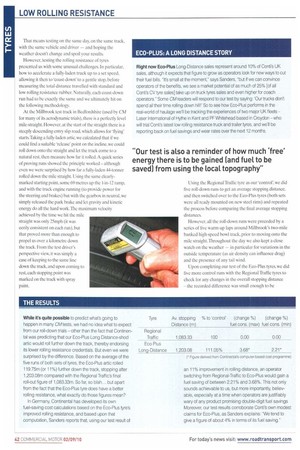THE RESULTS
Page 42

If you've noticed an error in this article please click here to report it so we can fix it.
While it's quite possible to predict what's going to happen in many CM tests, we had no idea what to expect from our roll-down trialsother than the fact that Continental was predicting that our Eco-Plus Long Distance-shod artic would roll further down the track, thereby endorsing its lower rolling resistance credentials. But even we were surprised by the difference. Based on the average of the five runs of both sets of tyres, the Eco-Plus artic rolled 119.75m (or 11%) further down the track, stopping after 1,203.08m compared with the Regional Traffic's final roll-out figure of 1,083.33m. So far, so blah, .. but apart from the fact that the Eco-Plus tyre does have a better rolling resistance, what exactly do those figures mean?
In Germany, Continental has developed its own fuel-saving cost calculations based on the Eco-Plus tyre's improved rolling resistance, and based upon that computation, Sanders reports that, using our test result of an 11% improvement in rolling distance, an operator switching from Regional-Traffic to Eco-Plus would gain a fuel saving of between 2.21% and 3.68%. This not only sounds achievable to us, but more importantly, believable, especially at a time when operators are justifiably wary of any product promising double-digit fuel savings Moreover, our test results corroborate Conti's own modest claims for Eco-Plus, as Sanders explains: We tend to give a figure of about 4% in terms of its fuel saving."
























































































































































































































































